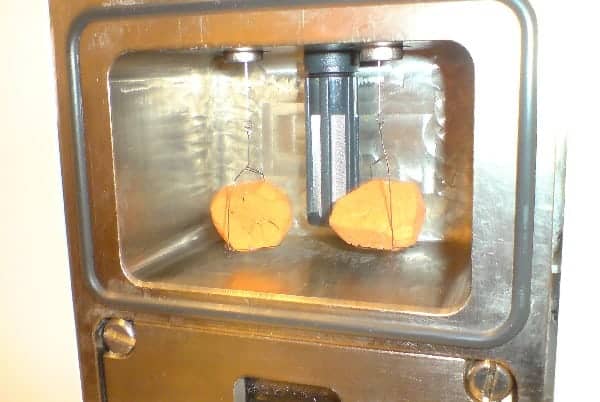
Researchers in the UK have created a new way of dating archaeological artefacts that involves heating ancient pots to unlock their internal clocks. The relatively simple technique could become as important for dating ceramics as carbon dating is for organic materials, say the researchers at the Universities of Manchester and Edinburgh. The team has already dated ceramics from the Roman, medieval and modern periods to a high degree of accuracy, and they are now looking to establish a global research facility for the technique.
The method relies on the fact that fired clay ceramics — like bricks, tile and pottery — start to chemically combine with water as soon as they are exposed to the atmosphere. A big breakthrough came in 2003 when the researchers realized that this process has occurred at a predictable rate throughout history, related to temperatures. Now the researchers have turned their theory into a practical dating method and present their findings in Proceedings of the Royal Society A.
Moira Wilson of the University of Manchester and her team document how “rehydroxlation dating” has so far dated objects up to 2000 years old, and they believe it could extend back as far as 10, 000 years. “Given the number and intensity of [dating] debates in archaeology, there is a huge gap in the field for this,” Wilson told physicsworld.com.
Slow chemical process
Wilson was quick to point out that the water uptake in rehydroxlation is not the same as absorption — it is a much slower chemical process. The researchers established that the rate at which ceramic materials gain extra water in this process obeys a (time)1/4 power law. They calculated that the rate of reaction is independent of atmospheric moisture levels but is governed by the ambient temperature averaged over a ceramic’s lifetime.
The dating procedure involves measuring the mass of a sample of ceramic and then heating it to around 500 degrees Celsius in a furnace, which removes the water. The re-fired ceramic is then weighed immediately, using a highly accurate microbalance, to determine precisely the rate of water recombination. Once the rate is known, the age of the artefact can be extrapolated. “There are no loose ends with this — everything ties in,” said Wilson.
The researchers dated a Roman brick, known to be 2001, as 2000 years old. They also tested a “mystery brick”, with the real age revealed to them only after their testing was completed — they got 340 years, and its known age was 339 to 344. An interesting thing occurred when they tested their technique on a medieval brick from Canterbury: after repeated testing dated it at 66 years, they realized that the intense heat generated during a Second World War blitz had re-fired the brick and effectively reset its clock.
Self-calibrating
At present, the most widely used alternative technique is thermoluminescence, which involves measuring the amount of light given off by a sample because this is related to the dose of radiation an artefact has received across its lifetime. One of the limitations is that it requires a lot of extra information about the archaeological site such as radiation levels, which may not be accessible if artefacts have already been sitting in a museum for many years. Perhaps the most significant feature of this new water-based technique is that — as with radiocarbon dating — it is self-calibrating, based on rehydroxylation alone.
“The time-dependent processes that they have studied looks very interesting,” said Ian Bailiff, an archaeologist at Durham University in the UK. However, Bailiff is a bit sceptical about the reliability of historic temperature records. “The devil is likely to be in the detail – the chronometric mechanism is temperature dependent, and much work may need to be done to obtain calibration data.”
The researchers are now planning to test whether their dating technique can be applied to earthenware, bone china and porcelain. Wilson told physicsworld.com that one of the main difficulties so far has been getting access to ceramics from museums and collectors who are yet to be convinced by the new technique. She believes this situation will improve if her team can establish an international research centre in the UK — she is currently looking into ways of achieving this.



